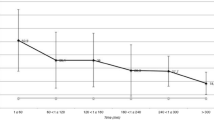Abstract
Introduction
Ketorolac 0.4% administered four times daily (q.i.d.) has long been used safely and effectively for the alleviation of ocular inflamation and pain and the prevention of intraoperative miosis in patients undergoing cataract surgery. Bromfenac ophthalmic solution 0.09% was recently developed as an ocular anti-inflammatory drug with a twice-daily (b.i.d.) dosing regimen. This study was designed to evaluate if b.i.d. dosing with bromfenac 0.09%, in comparison with q.i.d. dosing with ketorolac 0.4%, provides adequate trough nonsteroidal anti-inflammatory drug levels that were effective enough to reduce aqueous prostaglandin (PG) E2 levels of patients after cataract surgery toward the end of its dosing cycle.
Methods
In this single-center, investigator-masked trial, patients undergoing cataract surgery were randomized to receive either ketorolac 0.4% q.i.d. or bromfenac 0.09% b.i.d. for 2 days preoperatively. Aqueous humor was collected at the start of surgery 6 hours after the last dose of ketorolac 0.4% and 12 hours after the last dose of bromfenac 0.09%. Aqueous PGE2 levels and drug concentrations were evaluated by a competitive enzyme immunoassay and reverse-phase HPLC-mass spectroscopy, respectively.
Results
A total of 61 patients received ketorolac 0.4% (n=30) or bromfenac 0.09% (n=31). The mean (±SD) aqueous PGE2 level was 285.6±141.9 pg/mL in patients treated with ketorolac 0.4% and 386.2±131.0 pg/mL in patients treated with bromfenac 0.09% (P=0.006). The mean (±SD) aqueous concentrations of ketorolac and bromfenac were 83.6±73.8 ng/mL and 9.2±6.6 ng/mL, respectively (P<0.001).
Conclusions
Ketorolac 0.4% maintained significantly higher aqueous concentrations and lowered aqueous PGE2 levels significantly more than bromfenac 0.09% at trough levels. Ketorolac 0.4% administered q.i.d. may provide a more sustained control of intraocular inflammation and pain than bromfenac 0.09% administered b.i.d.
Similar content being viewed by others
References
Colin J. The role of NSAIDs in the management of postoperative ophthalmic inflammation. Drugs. 2007;67:1291–1308.
Heier J, Cheetham JK, Degryse R et al. Ketorolac tromethamine 0.5% ophthalmic solution in the treatment of moderate to severe ocular inflammation after cataract surgery: a randomized, vehicle-controlled clinical trial. Am J Ophthalmol. 1999;127:253–259.
Holzer MP, Solomon KD, Sandoval HP, Vroman DT. Comparison of ketorolac tromethamine 0.5% and loteprednol etabonate 0.5% for inflammation after phacoemulsification: prospective randomized double-masked study. J Cataract Refract Surg. 2002;28:93–99.
Rajpal RK, Cooperman BB. Analgesic efficacy and safety of ketorolac after photorefractive keratectomy. Ketorolac Study Group. J Refract Surg. 1999;15:661–667.
Solomon KD, Vroman DT, Barker D, Gehlken J. Comparison of ketorolac tromethamine 0.5% and rimexolone 1% to control inflammation after cataract extraction. Prospective randomized double-masked study. J Cataract Refract Surg. 2001;27:1232–1237.
Perry HD, Donnenfeld ED. An update on the use of ophthalmic ketorolac tromethamine 0.4%. Expert Opin Pharmacother. 2006;7:99–107.
Donnenfeld ED, Perry HD, Wittpenn JR, Solomon R, Nattis A, Chou T. Preoperative ketorolac tromethamine 0.4% in phacoemulsification outcomes: pharmacokinetic-response curve. J Cataract Refract Surg. 2006;32:1474–1482.
Price FW, Jr., Price MO, Zeh W, Dobbins K. Pain reduction after laser in situ keratomileusis with ketorolac tromethamine ophthalmic solution 0.5%: a randomized, double-masked, placebocontrolled trial. J Refract Surg. 2002;18:140–144.
Price MO, Price FW. Efficacy of topical ketorolac tromethamine 0.4% for control of pain or discomfort associated with cataract surgery. Curr Med Res Opin. 2004;20:2015–2019.
Sandoval HP, Férnandez De Castro LE, Vroman DT, Solomon KD. Evaluation of 0.4% ketorolac tromethamine ophthalmic solution versus 0.5% ketorolac tromethamine ophthalmic solution after phacoemulsification and intraocular lens implantation. J Ocul Pharmacol Ther. 2006;22:251–257.
Solomon KD, Donnenfeld ED, Raizman M et al. Safety and efficacy of ketorolac tromethamine 0.4% ophthalmic solution in post-photorefractive keratectomy patients. J Cataract Refract Surg. 2004;30:1653–1660.
Wittpenn JR, Silverstein S, Heier J et al. A randomized, masked comparison of topical ketorolac 0.4% plus steroid vs steroid alone in low-risk cataract surgery patients. Am J Ophthalmol. 2008;146:554–560.
Xibrom [package insert]. Irvine, CA, USA: ISTA Pharmaceuticals, Inc.; 2006.
Donnenfeld ED, Holland EJ, Stewart RH, Gow JA, Grillone LR, Bromfenac OPhthalmic Solution (Xibrom) Study Group. Bromfenac ophthalmic solution 0.09% (Xibrom) for postoperative ocular pain and inflammation. Ophthalmology. 2007;114:1653–1662.
Acular LS [package insert]. Irvine, CA, USA: Allergan, Inc.; 2003.
Koay P. The emerging roles of topical non-steroidal anti-inflammatory agents in ophthalmology. Br J Ophthalmol. 1996;80:480–485.
Warner TD, Mitchell JA. Cyclooxygenases: new forms, new inhibitors, and lessons from the clinic. FASEB J. 2004;18:790–804.
Bucci FA Jr., Waterbury LD. Comparison of ketorolac 0.4% and bromfenac 0.09% at trough dosing: aqueous drug absorption and prostaglandin E2 levels. J Cataract Refract Surg. 2008;34:1509–1512.
Decroos FC, Afshari NA. Perioperative antibiotics and anti-inflammatory agents in cataract surgery. Curr Opin Ophthalmol. 2008;19:22–26.
Bucci FA Jr., Waterbury LD, Amico LM. Prostaglandin E2 inhibition and aqueous concentration of ketorolac 0.4% (Acular LS) and nepafenac 0.1% (Nevanac) in patients undergoing phacoemulsification. Am J Ophthalmol. 2007;144:146–147.
Author information
Authors and Affiliations
Corresponding author
Rights and permissions
About this article
Cite this article
Bucci, F.A., Waterbury, L.D. Aqueous prostaglandin E2 of cataract patients at trough ketorolac and bromfenac levels after 2 days dosing. Adv Therapy 26, 645–650 (2009). https://doi.org/10.1007/s12325-009-0042-5
Received:
Published:
Issue Date:
DOI: https://doi.org/10.1007/s12325-009-0042-5




